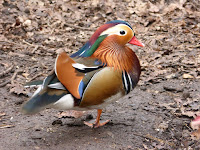 |
| Reed bunting |
A pale sky, blanket cloud filtering the Sun’s light as it
tried to break through. The songs of robins, blue tits and great tits serenaded
visitors as they tumbled out of their cars and into the reserve. Chatting to
one of the volunteers in the visitors centre, we were told that bearded tits
were showing well around the reserve, as were marsh harriers. With optimism, we
set out to see what we could find. The staccato shouts of wrens coming from the
sides of the visitor trails guided our way towards New Fen Viewpoint. A
serenely calm pool awaited us, the surface disturbed only by two coots dabbling
and diving, a few mallards and gadwalls and a great crested grebe proudly
showing its red mohican above a white cheek. A trail through the reed bed,
adjacent to the main path revealed more wrens. Cetti’s warblers began their appealing
song whilst remaining deep within the vegetation. The whistling calls of a coil
of wigeon passed overhead. Canada geese and mute swans graced the neighbouring
pools and a great spotted woodpecker could be heard drumming in the surrounding
trees.
 |
| Stonchat (m) |
Despite listening keenly for bearded tits on our way to Mere
hide, we were not in luck. The pool at the hide was just as calm as the
previous viewpoint, this time with a coot, a moorhen and four mallards
disturbing the placid water. A pair of wrens burst from the reeds, chasing each
other along a corridor through the vegetation. Never before today had I really
believed that the wren is the UK’s most numerous breeding bird. Almost as if
they were respecting the silence, a flock of lapwings flew over the hide as we
made our exit, their chunky square wings silhouetted against the brightening
sky. At the hide and on the trail leading away were empty platforms offering
grit to the invisible bearded tits.
On the trail to joist fen viewpoint, instead of bearded
tits, we found a reed bunting picking grit from the path, flying only a few
metres ahead each time we approached before eventually veering off into the
safety of reeds and trees.
 |
| Great white egret |
A footpath parallel to the reserve boundary, following the
River Little Ouse gave an elevated view over the reserve and surrounding
countryside. A pair of stonechats flitted between tall grasses and reed heads,
almost bouncing up and down as they transferred from one stem to another. A
kestrel hung in the sky, hovering, and then, missing its meal, rested in the
woodland trees. The lakes beyond the river, looking away from the reserve
boasted jewels of colour: shoveler, teal, lapwings, little egrets. The largest
was the tall, yellow-billed great white egret, towering above the little
egrets, despite being further away. Broken oyster shells littered the sides of
the path. Back in the reserve, a whole gang of long tailed tits decorated the
heads of tall reed stems and a single leafless tree amidst the rustling golden
stalks. They jingled through like early blossoms drifting from the tree.
Re-entering the reserve trail, blue tits and great tits
littered the feeders by the visitor’s centre and a kestrel perched on a tree in
the car park. A pair of roe deer bade us farewell at the reserve entrance.








